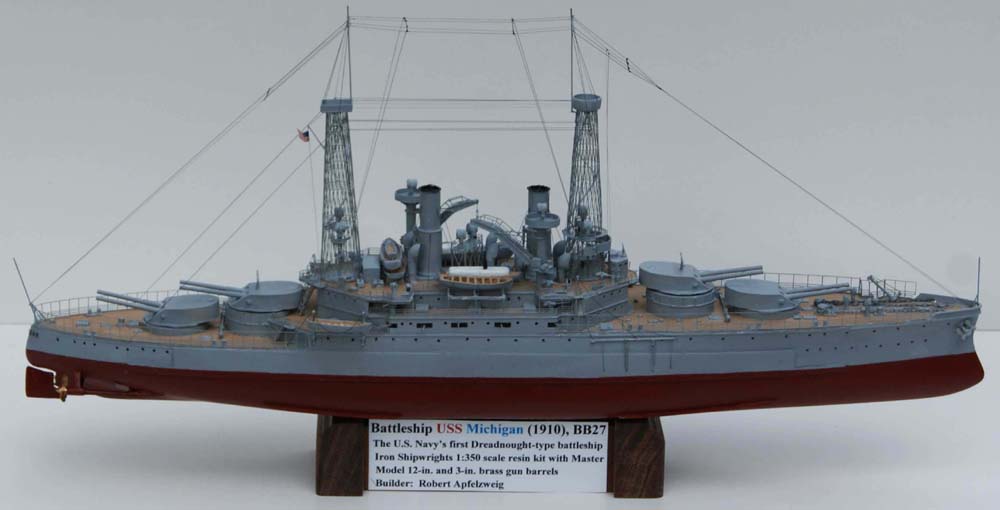
1/350 USS Michigan, BB-27 (ISW)
|
by Robert Apfelzweig |

1/350 USS Michigan, BB-27 (ISW)
The USS Michigan was the first Dreadnought-type battleship in the U.S. Navy. Although actually designed before the more famous and revolutionary HMS Dreadnought, it (and its sistership USS South Carolina, BB-28) were not completed and commissioned until several years after the Dreadnought. Nonetheless, these two American ships offered two new distinctions, and one disadvantage, when compared with the new British battleship. The Michigan and South Carolina were the first battleships to mount superfiring main gun turrets, all on the center line, a space- and weight-saving feature that took European navies several more years to fully adopt. These two vessels were also the first American ships to have the cage masts that became standard on all subsequent World War I-era American battleships as completed, and were retrofitted to the older American predreadnoughts within a few years. Unfortunately, the Michigan and South Carolina continued the earlier feature of reciprocating engines (versus the faster, more reliable turbines on the Dreadnought and her successors), so that their top speed of 18 knots was three knots slower than the British ship.ISW's model of the Michigan is generally good but, as usual with this company, fine resin parts are rather crudely cast and the assembly instructions are rudimentary. The full hull is cast in a single heavy piece and will need some cleanup on the keel and filling of various pits, both there and on the decks. There are no bollards on the main deck and I installed resin ones from L'Arsenal. ISW's resin gun barrels are poorly fashioned and I replaced them with 12-in. and 3-in. brass barrels from MasterModel. ISW provides various platforms for the brass cage masts to model the ship as she appeared during World War I convoy duty; however, I chose the simpler appearance of the ship as shortly after commissioning (in which the photoetch searchlight platforms had to be cut down from four to two on each mast). The cage masts themselves are incorrectly shaped (they should be somewhat hour-glass shaped) but I had no reliable way of modifying them. I had to scratch-build the rangefinders, spotting tops and flag bags, the anchors and most of the rowboats and motor launches came from my spare parts boxes, and the complicated rigging scheme (many of the cables were apparently part of the wireless communication antenna system), copied from some excellent online illustrations, is from stretched black plastic sprue. I selected Modelmaster light ghost gray for the upper hull and superstructure, Tamiya wood deck tan for the decks, and the lower hull was sprayed with Liquitex cadmium red hue.
